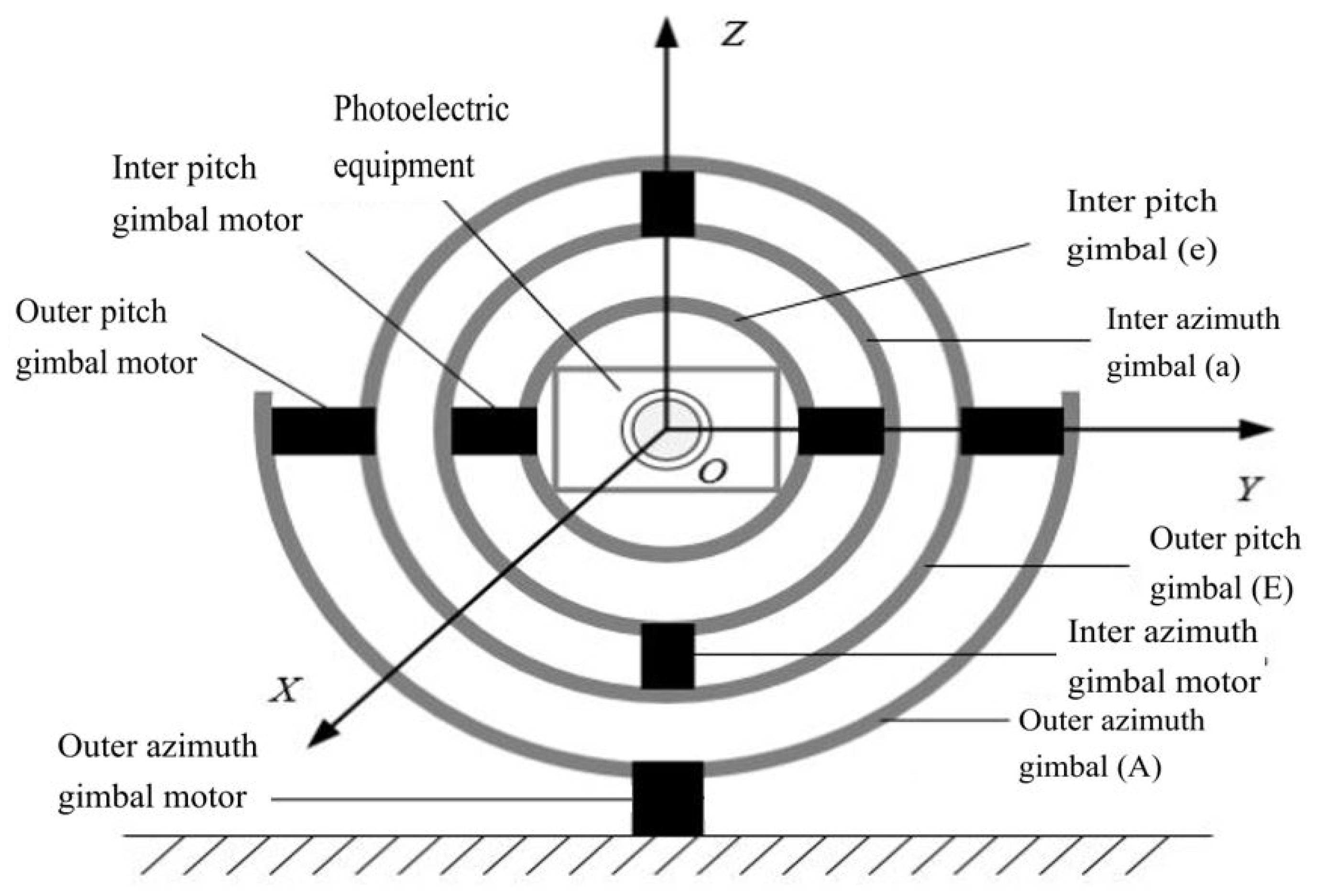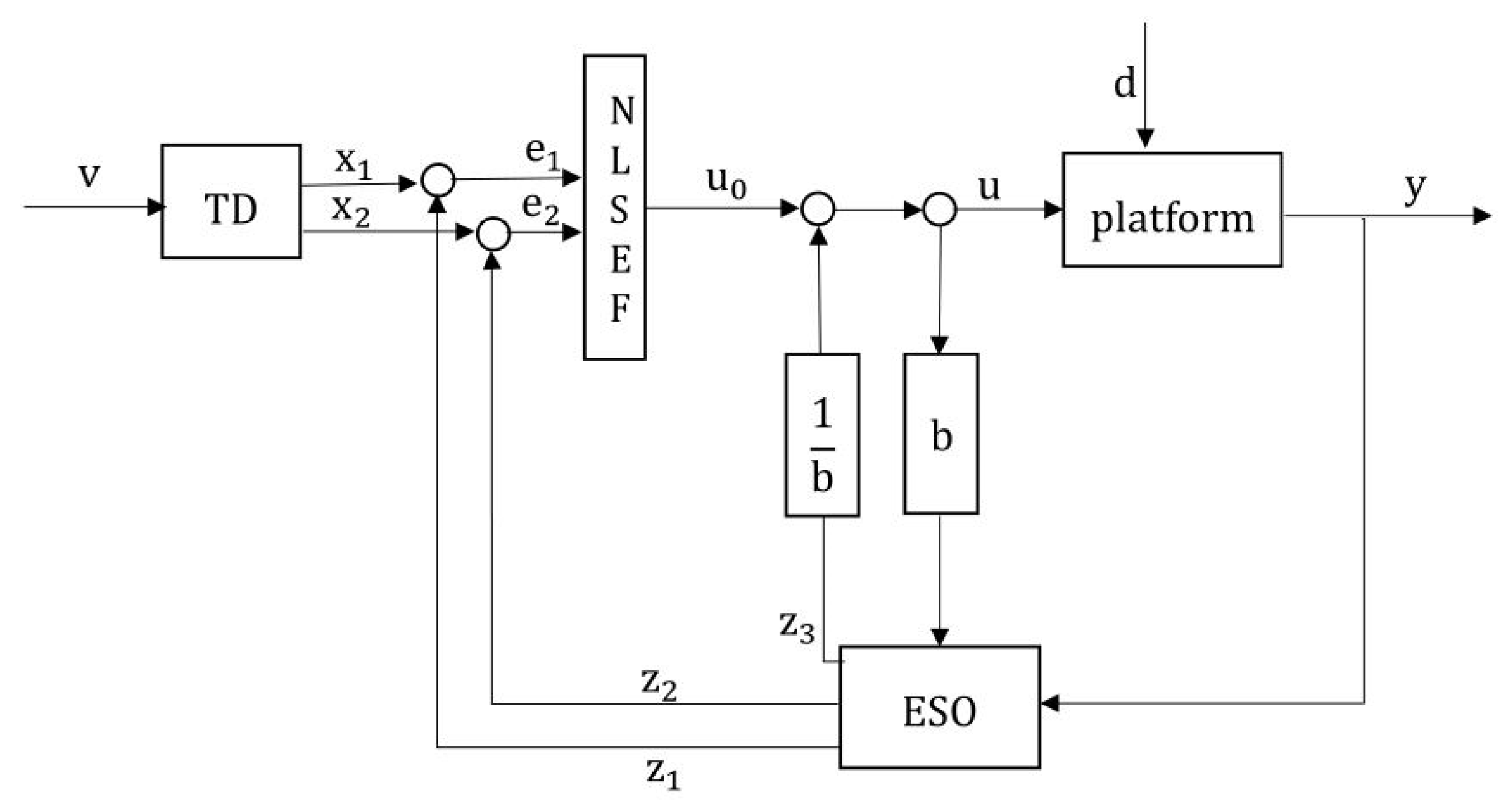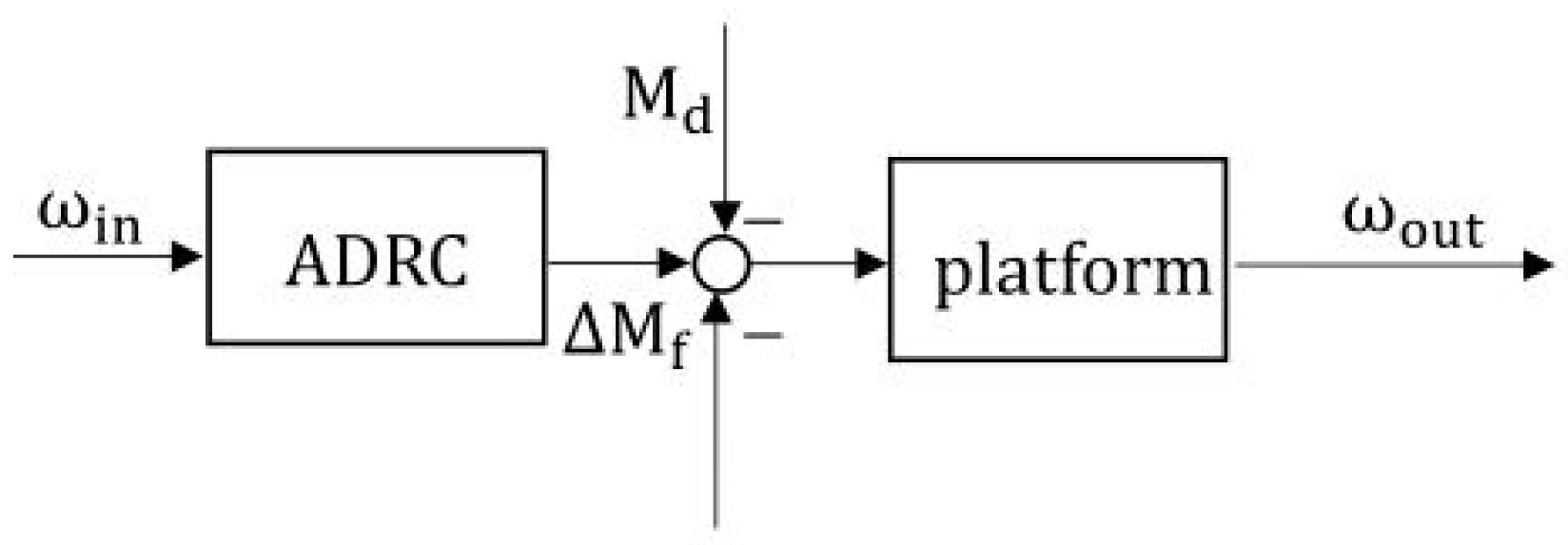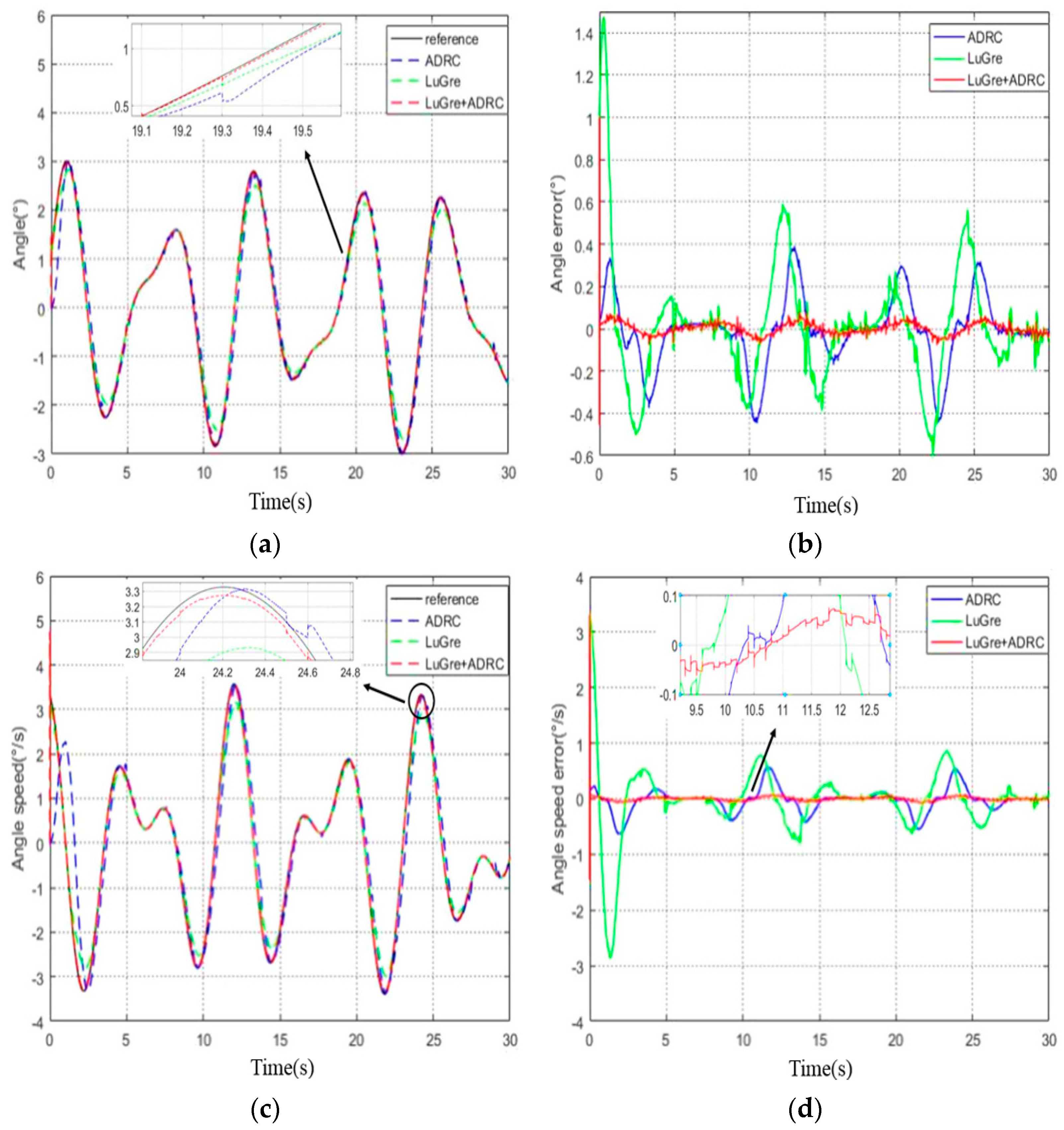Two-Axis Optoelectronic Stabilized Platform Based on Active Disturbance Rejection Controller with LuGre Friction Model
Abstract
:1. Introduction
2. Dynamics Model of Optoelectronic Stabilized Platform Systems
2.1. Closed-Loop Control System
2.2. Motor System
3. LuGre Model Parameter Identification
3.1. LuGre Model
3.2. Static Parameter Identification
3.3. Dynamic Parameter Identification
4. Controller Design
4.1. ADRC Algorithm
4.2. System Stability Analysis
5. Simulations and Results
5.1. Sinusoidal Trajectory Tracking Experiment
5.2. Multiple Sinusoidal Trajectory Tracking Experiment
6. Conclusions
Author Contributions
Funding
Institutional Review Board Statement
Informed Consent Statement
Data Availability Statement
Conflicts of Interest
References
- Thinh, H.; Minh-Thien, T.; Dong-Hun, L.; Soumayya, C.; Young-Bok, K. A study on vision-based backstepping control for a target tracking system. Actuators 2021, 10, 105. [Google Scholar]
- Tian, D.; Wang, M.; Wang, F.; Xu, R. Adaptive sliding-mode-assisted disturbance observer-based decoupling control for inertially stabilized platforms with a spherical mechanism. IET Control Theory Appl. 2022, 16, 1194–1207. [Google Scholar] [CrossRef]
- Xu, C.; Huang, D.; Liu, J. Target location of unmanned aerial vehicles based on the electro-optical stabilization and tracking platform. Measurement 2019, 147, 106848. [Google Scholar] [CrossRef]
- Chang, S.; Gao, B.; Zhang, G.; Bian, H. A new friction compensation method for photoelectric platform. J. Cent. S. Univ. 2021, 52, 434–442. [Google Scholar]
- Xie, M.; Liu, P.; Ma, C.; Hao, W.; Zhang, F. Application research of high-precision laser beam pointing technology in airborne aiming pod. Optik 2019, 183, 775–782. [Google Scholar] [CrossRef]
- Yang, Y.; Wu, Y.; Yang, F. Composite-observer-based adaptive robust control of electrical-optical gyro-stabilized platform with largely unknown modeling uncertainties and partial state feedback. Int. J. Adapt. Control Signal Process. 2022, 36, 1502–1523. [Google Scholar] [CrossRef]
- Zhou, X.; Zhao, B.; Liu, W.; Yue, H.; Yu, R. A compound scheme on parameters identification and adaptive compensation of nonlinear friction disturbance for the aerial inertially stabilized platform. ISA Trans. 2017, 67, 293–305. [Google Scholar] [CrossRef] [PubMed]
- Chen, P.; Liu, X.; Yan, Q. Adaptive friction compensation for a class of mechanical systems based on LuGre model. Int. J. Robust. Nonlinear Control. 2022, 32, 4510–4534. [Google Scholar] [CrossRef]
- Canudas de Wit, C.; Olsson, H.; Astrom, K.J.; Lischinsky, P. A new model for control of systems with friction. IEEE Trans. Autom. Control. 1995, 40, 419–425. [Google Scholar] [CrossRef] [Green Version]
- Yao, J.; Deng, W.; Jiao, Z. Adaptive control of hydraulic actuators with LuGre model-based friction compensation. IEEE Trans. Ind. Electron. 2015, 62, 6469–6477. [Google Scholar] [CrossRef]
- Yu, H.; Gao, H.; Deng, H.; Yuan, S.; Zhang, L. Synchronization control with adaptive friction compensation of treadmill-based testing apparatus for wheeled planetary rover. IEEE Trans. Ind. Electron. 2022, 69, 592–603. [Google Scholar] [CrossRef]
- Zhou, X.; Li, X. A finite-time robust adaptive sliding mode control for electro-optical targeting system with friction compensation. IEEE Access 2019, 7, 166318–166328. [Google Scholar]
- Yue, F.; Li, X. Robust adaptive integral backstepping control for opto-electronic tracking system based on modified LuGre friction model. ISA Trans. 2018, 80, 312–321. [Google Scholar] [CrossRef]
- Dong, F.; Lei, X.; Chou, W. A dynamic model and control method for a two-axis inertially stabilized platform. IEEE Trans. Ind. Electron. 2017, 64, 432–439. [Google Scholar] [CrossRef]
- Ding, Z.; Zhao, F.; Lang, Y.; Jiang, Z.; Zhu, J. Anti-disturbance neural-sliding mode control for inertially stabilized platform with actuator saturation. IEEE Access 2019, 7, 92220–92231. [Google Scholar] [CrossRef]
- Hwan-Cheol, P.; Soumayya, C.; Young-Bok, K.; Thinh, H. A nonlinear backstepping controller design for high-precision tracking applications with input-delay gimbal systems. J. Mar. Sci. Eng. 2021, 9, 530. [Google Scholar]
- Ji, W.; Li, Q.; Xu, B.; Zhao, D.; Fang, S. Adaptive fuzzy PID composite control with hysteresis-band switching for line of sight stabilization servo system. Aerosp. Sci. Technol. 2011, 15, 25–32. [Google Scholar] [CrossRef]
- Han, J. From PID to active disturbance rejection control. IEEE Trans. Ind. Electron. 2009, 56, 900–906. [Google Scholar] [CrossRef]
- Zhang, Y.; Chen, Z.; Zhang, X.; Sun, Q.; Sun, M. A novel control scheme for quadrotor UAV based upon active disturbance rejection control. Aerosp. Sci. Technol. 2018, 79, 601–609. [Google Scholar] [CrossRef]
- Zhang, N.; Gai, W.; Zhang, G.; Zhang, J. An active disturbance rejection control guidance law based collision avoidance for unmanned aerial vehicles. Aerosp. Sci. Technol. 2018, 77, 658–669. [Google Scholar] [CrossRef]
- Cao, C. Research on a visual servoing control method based on perspective transformation under spatial constraint. Machines 2022, 10, 1090. [Google Scholar] [CrossRef]
- Zhang, L.; Li, J.; Li, S.R.G. Vibration control of disturbed all-clamped plate with an inertial actuator based on cascade active disturbance rejection control. Machines 2022, 10, 528. [Google Scholar] [CrossRef]
- He, H.; Duan, H. A multi-strategy pigeon-inspired optimization approach to active disturbance rejection control parameters tuning for vertical take-off and landing fixed-wing UAV. Chin. J. Aeronaut. 2022, 35, 19–30. [Google Scholar] [CrossRef]
- Xia, Y.; Lin, M.; Zhang, J.; Fu, M.; Li, C. Trajectory planning and tracking for four-wheel steering vehicle based on differential flatness and active disturbance rejection controller. Int. J. Adapt. Control Signal Process. 2021, 35, 2214–2244. [Google Scholar] [CrossRef]
- Wang, L.; Liu, X.; Wang, C. Disturbance frequency adaptive control for photo-electric stabilized platform based on improving extended state observation. Optik 2019, 187, 198–204. [Google Scholar] [CrossRef]
- Zhou, X.; Gao, H.; Zhao, B.; Zhao, L. A GA-based parameters tuning method for an ADRC controller of ISP for aerial remote sensing applications. ISA Trans. 2018, 81, 318–328. [Google Scholar] [CrossRef]
- Zhou, X.; Li, X. Trajectory tracking control for electro-optical tracking system using ESO based fractional- order sliding mode control. IEEE Access 2021, 9, 45891–45902. [Google Scholar] [CrossRef]
- Bai, C.; Zhang, Z. A least mean square based active disturbance rejection control for an inertially stabilized platform. Optik 2018, 174, 609–622. [Google Scholar] [CrossRef]
- Qu, J.; Xia, Y.; Shi, Y.; Cao, J.; Wang, H. Modified ADRC for inertial stabilized platform with corrected disturbance compensation and improved speed observer. IEEE Access 2020, 8, 157703–157716. [Google Scholar] [CrossRef]
- Li, Y.; Jia, J.; Zhao, S.; Liu, W.; Li, J. Identification and compensation of nonlinearity for airborne electromechanical actuator based on Matlab/dSPACE. In Proceedings of the 13th IEEE Conference on Industrial Electronics and Applications (ICIEA), Wuhan, China, 31 May–2 June 2018; pp. 2612–2617. [Google Scholar]
- Leonid, F.; Anders, R.; Anton, S.; Rolf, J. LuGre-model-based friction compensation. IEEE Trans. Control Syst. Technol. 2010, 18, 194–200. [Google Scholar]
- Barabanov, N.; Ortega, R. Necessary and sufficient conditions for passivity of the LuGre friction model. IEEE Trans. Autom. Control. 2000, 45, 830–832. [Google Scholar] [CrossRef]
- Liu, L.; Wu, Z. Comprehensive parameter identification of feed servo systems with friction based on responses of the worktable. Mech. Syst. Signal Process. 2015, 64–65, 257–265. [Google Scholar] [CrossRef]
- Wang, X.; Wang, S. High performance adaptive control of mechanical servo system with lugre friction model: Identification and compensation. J. Dyn. Syst. Meas. Control. 2012, 134, 011021. [Google Scholar] [CrossRef] [Green Version]
- Vargas, F.; Edson, R. Identification and friction compensation for an industrial robot using two degrees of freedom controllers. In Proceedings of the 8th International Conference on Control, Automation, Robotics and Vision (ICARCV), Kunming, China, 6–9 December 2004; Volume 2, pp. 1146–1151. [Google Scholar]
- Yang, Z.; Zhang, Q.; Chen, Z. Adaptive distributed convex optimization for multi-agent and its application in flocking behavior. J. Franklin Inst. 2019, 356, 1038–1050. [Google Scholar] [CrossRef]








| Parameters | Value |
|---|---|
| Total moment of inertia (kg) | J = 1.1 |
| Motor resistance (Ω) | = 4.2 |
| Motor inductance (mH) | = 3.78 |
| Torque coefficient (Nm/A) | = 3.478 |
| Back-EMF coefficient (V∙s/deg) | = 0.78 |
| Stiction force (Nm) | = 0.6 |
| Coulomb friction (Nm) | = 0.15 |
| Viscous friction coefficient (Nm∙s/deg) | = 0.02 |
| Stribeck angular velocity (deg/s) | = 0.05 |
| Stiffness coefficient (Nm/deg) | = 47.3 |
| Damping coefficient (Nm∙s/deg) | = 0.73 |
| Controller | ADRC | LuGre | LuGre + ADRC |
|---|---|---|---|
| Angle error (MAX) | 0.1884° | 0.4418° | 0.0628° |
| Angle error (RMX) | 0.0323° | 0.1764° | 0.0121° |
| Angle speed error (MAX) | 0.4638°/s | 0.9837°/s | 0.0693°/s |
| Angle speed error (RMX) | 0.0832°/s | 0.3987°/s | 0.0176°/s |
| Controller | ADRC | LuGre | LuGre + ADRC |
|---|---|---|---|
| Angle error(MAX) | 0.3801° | 0.5834° | 0.0542° |
| Angle error(RMX) | 0.0752° | 0.1467° | 0.0117° |
| Angle speed error(MAX) | 0.5365°/s | 0.7737°/s | 0.0737°/s |
| Angle speed error(RMX) | 0.0973°/s | 0.1447°/s | 0.0189°/s |
Disclaimer/Publisher’s Note: The statements, opinions and data contained in all publications are solely those of the individual author(s) and contributor(s) and not of MDPI and/or the editor(s). MDPI and/or the editor(s) disclaim responsibility for any injury to people or property resulting from any ideas, methods, instructions or products referred to in the content. |
© 2023 by the authors. Licensee MDPI, Basel, Switzerland. This article is an open access article distributed under the terms and conditions of the Creative Commons Attribution (CC BY) license (https://creativecommons.org/licenses/by/4.0/).
Share and Cite
Hu, X.; Han, S.; Liu, Y.; Wang, H. Two-Axis Optoelectronic Stabilized Platform Based on Active Disturbance Rejection Controller with LuGre Friction Model. Electronics 2023, 12, 1261. https://doi.org/10.3390/electronics12051261
Hu X, Han S, Liu Y, Wang H. Two-Axis Optoelectronic Stabilized Platform Based on Active Disturbance Rejection Controller with LuGre Friction Model. Electronics. 2023; 12(5):1261. https://doi.org/10.3390/electronics12051261
Chicago/Turabian StyleHu, Xueyan, Shunjie Han, Yangyang Liu, and Heran Wang. 2023. "Two-Axis Optoelectronic Stabilized Platform Based on Active Disturbance Rejection Controller with LuGre Friction Model" Electronics 12, no. 5: 1261. https://doi.org/10.3390/electronics12051261





